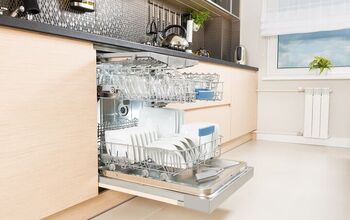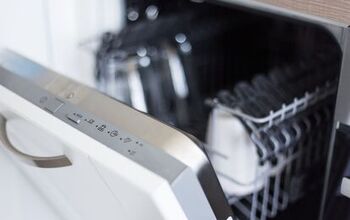Is Your Dishwasher Making A High Pitched Noise? (Fix It Now!)

It can be a frustrating situation. Your dishwasher begins to make high-pitched noises when it is running. Sometimes it can get so bad you can’t stand to be in the kitchen. There are several causes for high-pitched noises in an operating dishwasher.
Most often, the cause of a high-pitched noise or whine in a dishwasher is a bad water circulation pump or a bad drain pump. A clog or residue build-up in the water circulation system may also cause these kinds of noises. In most instances, the bearing in the pump wears out and the pump needs replacing.
Don’t despair. If your dishwasher is still under warranty, the manufacturer may repair the machine. If your dishwasher is older, replacing the pump in most dishwashers is possible. Following a few simple steps can have your dishwasher running like new without the annoying noise.
Related Content: Dishwasher Brands To Avoid | Is It Worth Fixing A Dishwasher? | How To Test A Dishwasher Pump Motor
Don't want to do it yourself?
Get free, zero-commitment quotes from pro contractors near you.

Why Your Dishwasher Is Making Noise
Eliminating the Offending Noise
The goal, of course, is to get your dishwasher running without the high-pitched noise. Most often, the noise is the symptom of problems in the water circulation system. The heart of the circulation system is the water pump. It is the water pump that is most often the cause of these annoying noises.
Check your Warranty
The first step is always to check your warranty. Manufacturers’ warranties vary in length and the parts of the dishwasher they cover. Check your warranty documents carefully to determine if your dishwasher is still under warranty and if the water pump is covered. If so, make a call to the manufacturer or dealer and schedule an appointment.
Replacing a Bad Water Pump
If your dishwasher is out of warranty, your problem may be a bit larger but not unsolvable. Replacing a bad water pump on most dishwashers is relatively easy, given a few helpful tips and tricks. These step-by-step instructions should have your dishwasher purring like a happy kitten in no time.
Step 1: Gather the Parts
Before you start, make sure you have all the parts you need on hand and ready to install. There is nothing worse than taking apart your dishwasher only to find out the local parts dealer doesn’t have the correct part in stock. Living with a disassembled dishwasher for a week waiting for a part to arrive is no fun.
Locate the model number and the serial number on your dishwasher. These numbers are on a label attached to the inside edge of the door pocket. You will need both these numbers to get the right part for your dishwasher.
Visit your local appliance parts dealer. Your parts dealer can look up the right parts using the model number and serial number. Your dealer can also advise you on any other parts you may need, such as replacement gaskets, hoses, and hose clamps. Often, the dishwasher manufacturer recommends that you replace these parts as well.
Step 2: Have the Right Tools
Make sure that you have the right tools on hand for the job. In most cases, you will need, at a minimum, the following tools.
- Screwdrivers – Phillips and Straight. Some new appliances use Torx screwdrivers
- Nut Drivers – Many manufacturers use hex-head sheet metal screws to hold the dishwasher frame’s service panels. A set of hex nut drivers will save you a lot of time.
- Pliers – A pair of pliers is handy for removing spring clips and hose clamps
- Flashlight – the inside of your dishwasher can get dark. A flashlight can be a lifesaver at times.
- Towels or rags – Dishwashers tend to hold water around the pump. Inevitably there will be water in the hoses and it will spill. Be prepared to mop up the water with some towels or rags as your work.
Step 3: Work Safe – Eliminate the Hazards
The biggest hazard of working with appliances is the electrical connections. Before you attempt to make any repair to your dishwasher, eliminate this danger. Unplug the dishwasher from the wall outlet. You may also shut off the circuit breaker that serves the dishwasher.
It is a wise idea to turn off the water supply to the dishwasher as well. The chances that water will start to flow into the dishwasher are minimal at the most, but it doesn’t hurt to be careful.
Step 4: Slide the Dishwasher from Under the Counter
Open the dishwasher and look under the front edge of the countertop of your cabinets. Your dishwasher probably has two brackets that screw to the countertop’s underside or the rail of your cabinet. Remove the screws in the brackets.
You may also need to unhook the drain hose from the sink drain to have enough room to remove the dishwasher. While you are under the sink, check the electrical connection and make sure there is enough wire to allow the dishwasher to slide out from under the cabinet.
Carefully pull the dishwasher from under the cabinet far enough to turn it. You need to have clear access to the back of the dishwasher to access the pump.
Step 5: Locate and Access the Drain Pump
The drain pump and motor are usually a single assembly and should be easy to spot. It may be easier to access the drain pump and motor assembly from the bottom of the dishwasher on some dishwasher models. If this is the case, lay a towel on the floor and tilt the dishwasher onto its back to make access easier.
If you must access the drain pump from the back, remove the service panel on the back of your dishwasher and set it aside. Be sure to put the screws in a safe place. With the back removed, you should see the pump and motor assembly
Step 6: Remove the Hose Clamps and Hoses
Put some towels or rags under the pump assembly to absorb any water that runs from the hoses or pumps during disassembly. Remove the hose clamps from the hoses attached to the pump. Removing the clamps may require a pair of pliers for spring clamps or a nut driver or screwdriver for screw-type clamps.
Pull the hoses from the pump assembly. Be prepared for a bit of water. It is best to clean up any spills as they occur to keep a clean and dry work area. Keeping things dry can prevent more problems with your dishwasher later.
Step 7: Unplug the Wiring Harness
On most dishwasher pump assemblies, the dishwasher pump controls, and power use a single multi-plug wiring harness. Locate this multi-plug, disconnect it putting the wire aside. Many of these multi-plugs have a lock tab that must be depressed or squeezed to remove the plug.
Step 8: Remove the Pump Assembly
This step can be the most challenging. On some dishwashers, the pump is attached to the drain sump using a gasket and screws. In this case, remove the screws and carefully remove the pump assembly. Remove the old gasket as well. You can discard the old gasket. You must install a new gasket when replacing the pump assembly.
The pump assembly is removed on newer dishwashers by twisting the entire assembly 1.4 turns counterclockwise and pulling the mount from the sump. You may need to find and press the locking tab on the mount to allow the pump assembly to turn.
Step 9: Look for Other Wires, Valves, or Sensors
Depending on the model, maker, or style of the dishwasher, there may be other valves, diverters, or sensors attached to the water pump. You must remove or unplug these parts to remove the pump assembly.
Step 9: Installing the New Pump
Reinstall any valves or diverters that you took off the old pump onto the new pump. Make sure the wires to these auxiliary parts are tight. If any of these valves or diverters have gaskets or seals, install new parts during the re-assembly.
Clean the area of the sump pan where the pump assembly connects. This step is important to endure a watertight seal with the new pump assembly. Reinstall the pump assembly in the reverse order of the removal.
Connect the hoses and tighten the hose clamps.
Step 10: Reinstall the Dishwasher
Set the dishwasher back on its feet and replace the back panel. Feed the electrical wire and drain line back under the sink as you slide the dishwasher under the countertop. Replace the screws on the support brackets.
Connect the drain line to the main sink drain and plug the electrical line back into the wall outlet. If you turned the circuit breaker off, now is the time to turn it back on.
If you removed the dish baskets or spray arms, replace these parts and open the water supply valve if it was disconnected and turned off.
Step 11: Take it for a Test Drive
Run your repaired dishwasher through a complete cycle while it is empty and with no dishwasher soap. Check for any leaks under the dishwasher and the connections to the water supply and the drain.
If there are no leaks and the annoying high-pitched sounds are gone, the project is a success.
Aside from a high pitched noise, there are a variety of other issues you may be facing with your dishwasher. Stopping Mid-Cycle? or Upper Spray Arm Not Spinning?
Don't want to do it yourself?
Get free, zero-commitment quotes from pro contractors near you.

Congratulations!
Congratulations on successfully eliminating that aggravating high=pitched noise made by your dishwasher. Your dishwasher should give you many more years of service. Job well done!
More Related Guides

Dennis is a retired firefighter with an extensive background in construction, home improvement, and remodeling. He worked in the trades part-time while serving as an active firefighter. On his retirement, he started a remodeling and home repair business, which he ran for several years.
More by Dennis Howard



























